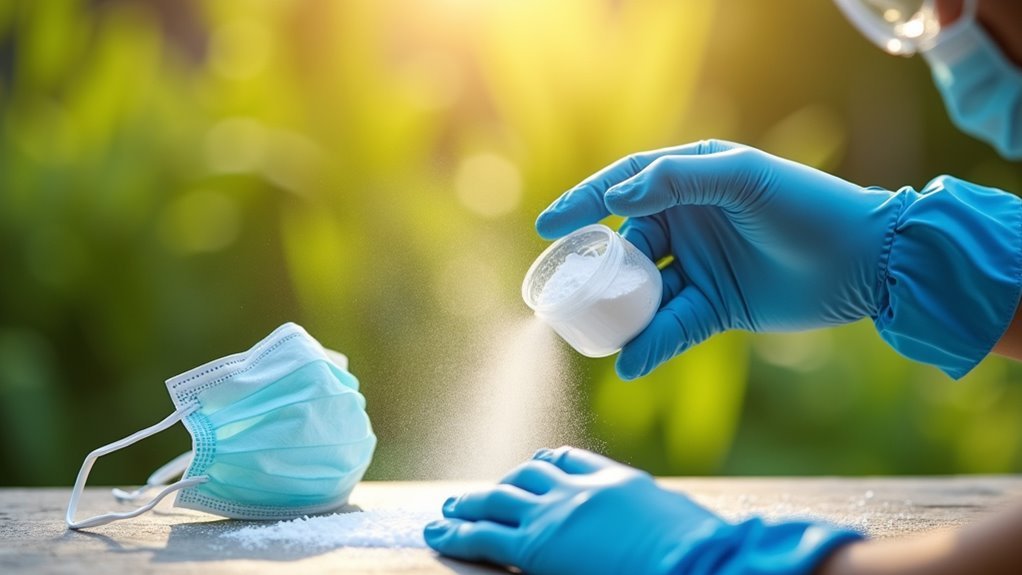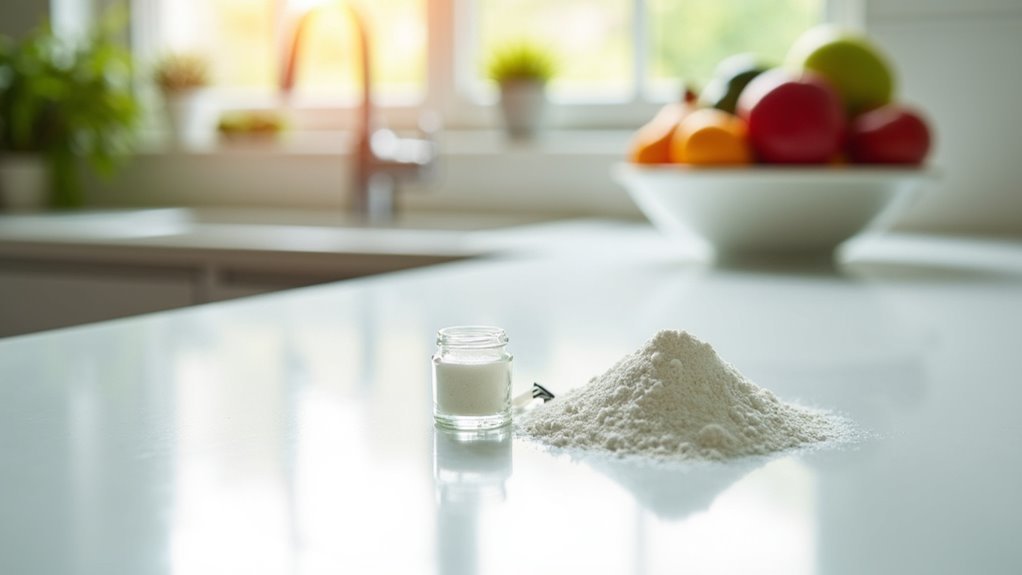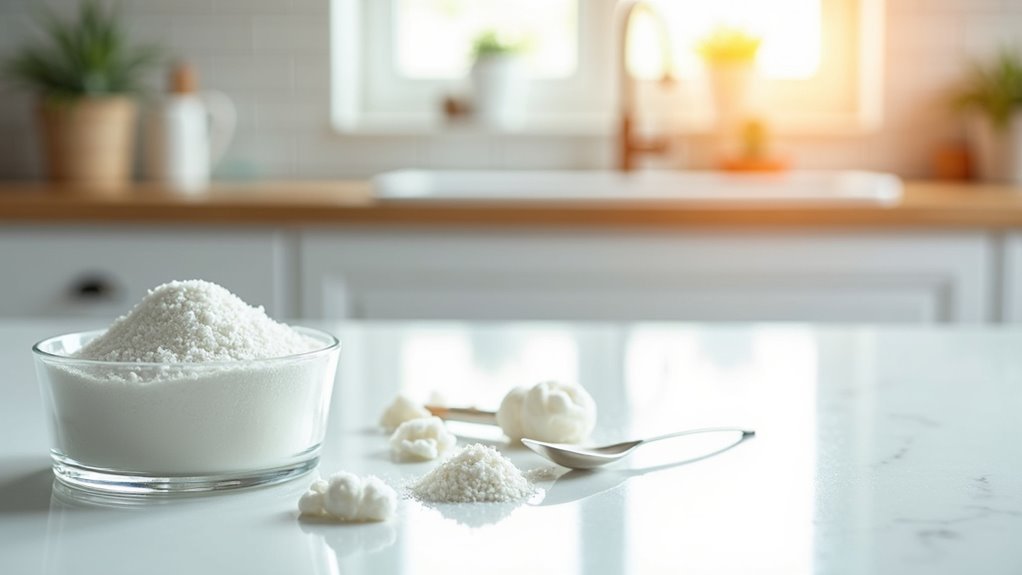You can apply boric acid powder safely by wearing protective gloves and masks during application. Target cracks, crevices, and baseboards with thin, even layers rather than thick piles. Use tamper-resistant bait stations in high-activity areas to contain the powder and prevent accidental exposure. Keep applications at least three feet away from food preparation surfaces and only apply in dry, well-ventilated spaces. Store powder in original containers away from children and pets. These seven methods will maximize pest control effectiveness while protecting your household from harm.
Wear Proper Protective Equipment During Application

Before you begin applying boric acid powder, you’ll need to gear up with essential protective equipment to safeguard your health.
Start by putting on waterproof gloves to prevent direct skin contact, as prolonged exposure can cause irritation. You should wear protective eyewear to shield your eyes from airborne particles that could cause injury during boric acid application.
Always wear waterproof gloves and protective eyewear when handling boric acid to prevent skin irritation and eye injury from airborne particles.
Cover your skin with long-sleeve shirts and pants to minimize exposure in areas where powder might settle. Don’t forget to wear a protective mask, since inhaling boric acid dust can irritate the respiratory system.
This protective gear is essential for safe handling. Always verify you’re working in a well-ventilated area to reduce inhalation risks and enhance overall safety during application.
Target Cracks and Crevices for Maximum Effectiveness
When applying boric acid powder, you’ll achieve the best results by focusing on cracks and crevices where pests commonly hide and travel. These tight spaces serve as highways for common household pests like cockroaches and ants, making them ideal application points.
To target cracks and crevices effectively:
- Apply thin, fine layers that adhere well to surfaces.
- Focus on dry areas where moisture won’t diminish effectiveness.
- Concentrate on baseboards, cabinet gaps, and wall joints.
- Avoid accessible surfaces to minimize risk to humans and pets.
The strategic placement guarantees the powder remains effective over time while maximizing pest contact.
Since boric acid works slowly, insects return to their nests after exposure, spreading the toxicant throughout the colony and disrupting entire populations.
Apply Thin Layers in Strategic Locations

You’ll achieve the best results by applying boric acid powder in thin, even layers rather than thick piles that pests might avoid.
Focus your application on strategic locations where pests naturally travel, such as along baseboards, behind appliances, and near entry points like door frames and window sills.
The key is using a light dusting technique that creates an invisible barrier pests will unknowingly walk through, ensuring they pick up the powder on their bodies.
Target Pest Pathways
Since cockroaches and other pests follow predictable travel routes throughout your home, you’ll achieve better results by targeting these specific pathways with thin layers of boric acid powder.
These household pests consistently use the same corridors to access food, water, and shelter.
To target specific pest pathways effectively, apply boric acid in these key locations:
- Cracks and crevices along walls where insects hide during daylight hours
- Behind major appliances like refrigerators, stoves, and dishwashers
- Under cabinets and sinks where moisture attracts various pests
- Around pipe openings and utility entry points
These control methods maximize contact between pests and the boric acid powder, ensuring they’ll walk through treated areas repeatedly during their normal activities.
Dust Application Technique
Proper application technique determines whether your boric acid treatment succeeds or fails against household pests. Use a bulb duster to apply boric acid dust in thin, even layers rather than thick piles that deter insects. Focus on cracks and crevices where pests hide and travel, ensuring maximum contact with boric acid for effective household pest control.
| Application Method | Effectiveness |
|---|---|
| Thin, even layers | High – attracts pests |
| Thick piles | Low – deters insects |
| Strategic placement | Maximum contact achieved |
When you apply boric acid, target entry points and hiding spots while keeping areas dry. Moisture reduces powder effectiveness, so maintain dry conditions. Regularly check and replenish dust in strategic locations to sustain long-term pest control results.
Use Bait Stations to Contain Powder Safely
When targeting cockroaches with boric acid powder, bait stations offer the safest application method for households with children and pets. These specialized containers securely hold the powder while preventing accidental exposure, making them ideal for effective pest control without compromising safety.
You can strategically place bait stations in high-activity areas where cockroaches frequent:
- Under kitchen and bathroom sinks
- Behind major appliances like refrigerators and stoves
- Inside cabinet corners and pantry areas
- Along baseboards in dark, humid spaces
The tamper-resistant design limits powder dispersal, reducing contamination risks to surfaces and food items.
You’ll need to monitor these stations regularly, replacing depleted boric acid as needed. This containment method guarantees targeted pest elimination while maintaining household safety standards, making it the preferred choice for responsible homeowners.
Keep Applications Away From Food Preparation Areas

You’ll need to establish clear safe zone boundaries that keep boric acid applications several feet away from countertops, sinks, and cooking surfaces.
Focus your treatment efforts on targeting gaps behind appliances like refrigerators and stoves, where pests hide but food contamination risks remain minimal.
This strategic approach prevents kitchen contamination while still addressing pest problems in areas where cockroaches and ants commonly travel.
Safe Zone Boundaries
Establishing clear boundaries between boric acid applications and food preparation zones is critical for preventing contamination and ensuring household safety.
When creating safe zone boundaries, you’ll need to maintain strict separation between treatment areas and spaces where food is handled.
Follow these essential guidelines for proper application areas:
- Keep boric acid at least 3 feet away from countertops, tables, and kitchen islands.
- Apply only in inaccessible locations like cracks, crevices, and behind appliances.
- Use tamper-resistant bait stations near food zones to protect children and pets.
- Clean all surfaces thoroughly after application to remove any residue.
Always consult product labels for specific safety instructions regarding food preparation boundaries, ensuring you’re maintaining adequate distance between treatment zones and cooking areas.
Kitchen Contamination Prevention
Since kitchens serve as the heart of food preparation, protecting these spaces from boric acid contamination requires extra vigilance and strategic placement techniques.
You’ll need to maintain strict boundaries between treatment areas and food preparation surfaces. Always apply boric acid in hidden cracks and crevices, never on countertops or tables where you handle food.
Use protective barriers like wax paper squares or bottle caps when placing boric acid near potential food sources. This prevents direct contact with surfaces you’ll later use for cooking.
Keep the powder away from cooking utensils, dishes, and food storage areas to avoid cross-contamination. After each safe application, thoroughly clean surrounding areas to remove any accidental spills or residue that could compromise kitchen contamination prevention efforts.
Appliance Gap Targeting
Three critical zones around kitchen appliances offer perfect hiding spots for cockroaches while keeping your boric acid applications safely away from food prep areas.
You’ll find these gaps provide ideal conditions for pest control without compromising household safety.
Focus your efforts on these strategic locations:
- Behind refrigerators – Apply boric acid powder in the narrow space between the appliance and wall.
- Underneath stove units – Target the dark recesses where cockroaches frequently nest.
- Around dishwasher bases – Concentrate on gaps where moisture and warmth attract pests.
- Behind microwave stands – Access hidden areas where cockroaches travel.
These zones remain completely separate from food preparation surfaces, ensuring your applications stay effective while maintaining kitchen safety standards.
Apply Only in Dry, Well-Ventilated Spaces
When applying boric acid powder, you’ll achieve the best results by choosing dry, well-ventilated spaces where moisture won’t compromise the treatment’s effectiveness.
Moisture reduces boric acid’s residual action, making your pest control efforts less effective. You should avoid bathrooms, kitchens, and other areas prone to water exposure, as the powder can wash away easily.
Proper ventilation is essential when you apply boric acid in dry conditions. Well-ventilated areas prevent airborne particles from accumulating, reducing respiratory irritation risks.
Use a dust applicator or bulb duster for precise application, minimizing powder dispersion into the air.
Regularly inspect your application sites to guarantee they remain dry. Reapply boric acid as needed to maintain effective, ongoing pest control throughout your treatment areas.
Store and Handle Powder According to Safety Guidelines
Proper storage and handling practices protect you and your household from potential health risks while maintaining boric acid’s effectiveness. Following established safety guidelines guarantees you’ll avoid accidental exposure while maximizing the powder’s pest control benefits.
When you handle and store boric acid powder, implement these essential precautions:
- Store in original containers with tight seals, clearly labeled and away from children and pets.
- Choose cool, dry storage locations to prevent powder degradation.
- Wear protective equipment including gloves, masks, and long sleeves during application.
- Keep boric acid away from food preparation areas and cooking utensils.
You must also guarantee proper disposal of excess powder according to local regulations.
Never allow boric acid to contaminate water sources or enter storm drains, as environmental protection remains vital for community safety.
Frequently Asked Questions
What Is the Best Way to Apply Boric Acid?
You’ll get best results by using a bulb duster to apply thin layers in cracks, crevices, and pest entry points. Don’t create large piles, wear protective gear, and follow label instructions carefully.
How to Apply Boric Acid Powder on Skin?
You shouldn’t apply boric acid powder directly on skin as it causes irritation. If accidental contact occurs, immediately wash the affected area thoroughly with soap and water to minimize potential harm.
What Are the Safety Precautions for Boric Acid?
You should wear protective gear including gloves and masks, keep boric acid away from food and children, guarantee proper ventilation, and follow label instructions carefully to prevent skin irritation and accidental ingestion.
Is Boric Acid Powder Safe to Touch?
You shouldn’t touch boric acid powder directly since it’ll irritate your skin. Always wear protective gloves when handling it, and wash your hands thoroughly afterward to prevent any potential skin reactions.
In Summary
You’ve learned the essential safety methods for applying boric acid powder effectively. Remember to always wear protective gear and target specific areas where pests hide. Keep your applications thin and contained, especially using bait stations when possible. Don’t forget to maintain proper ventilation and store your powder safely. By following these guidelines, you’ll achieve better pest control results while protecting your family’s health and safety.





Leave a Reply